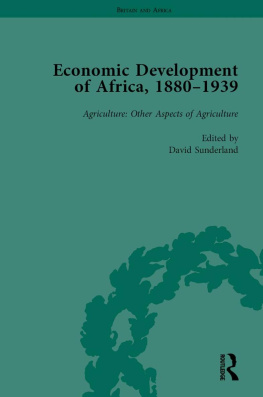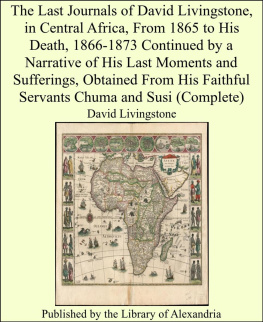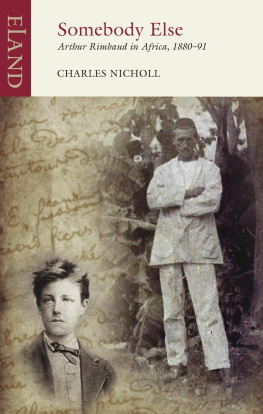BRITAIN AND AFRICA SERIES
COMMUNICATIONS IN AFRICA, 18801939
BRITAIN AND AFRICA SERIES
Series Editor: Advisory Editor: | David Sunderland Godfrey N. Uzoigwe |
TITLES IN THIS SERIES
Economic Development of Africa, 18801939
David Sunderland (ed.)
FORTHCOMING TITLES
The Government and Administration of Africa, 18801939
Casper Andersen and Andrew Cohen (eds)
CONTENTS OF THE EDITION
VOLUME 1
General Introduction
Railways: Proposals
VOLUME 2
Railways: Construction
VOLUME 3
Railways: Operation
VOLUME 4
Railways: Operation and Economic Impact
VOLUME 5
Other Forms of Communication
Index
First published 2012 by Pickering & Chatto (Publishers) Limited
Published 2016 by Routledge
2 Park Square, Milton Park, Abingdon, Oxon OX14 4RN
711 Third Avenue, New York, NY 10017, USA
Routledge is an imprint of the Taylor & Francis Group, an informa business
Copyright Taylor & Francis 2012
Copyright Editorial material David Sunderland 2012
To the best of the Publishers knowledge every effort has been made to contact relevant copyright holders and to clear any relevant copyright issues.
Any omissions that come to their attention will be remedied in future editions.
All rights reserved, including those of translation into foreign languages. No part of this book may be reprinted or reproduced or utilised in any form or by any electronic, mechanical, or other means, now known or hereafter invented, including photocopying and recording, or in any information storage or retrieval system, without permission in writing from the publishers.
Notice:
Product or corporate names may be trademarks or registered trademarks, and are used only for identification and explanation without intent to infringe.
BRITISH LIBRARY CATALOGUING IN PUBLICATION DATA
Communications in Africa, 18801939. (Britain and Africa)
1. Railroads Africa Planning Sources. 2. Railroads Africa Design and construction History 19th century Sources. 3. Railroads Africa -Design and construction History 20th century Sources. 4. Railroads -Africa Management History 20th century Sources. 5. Railroads Africa Economic aspects History 19th century Sources. 6. Railroads Africa Economic aspects History 20th century Sources. 7. Communication and traffic Africa History 19th century Sources. 8. Communication and traffic Africa History 20th century Sources. 9. Great Britain Colonies Africa Administration History 19th century Sources. 10. Great Britain Colonies Africa Administration History 20th century Sources.
I. Series II. Sunderland, David.
385.09609034-dc23
ISBN-13: 978-1-84893-064-3 (set)
Typeset by Pickering & Chatto (Publishers) Limited
As discussed in the General Introduction in Volume 1, railways in West Africa were constructed by the department system and Public Works departments (PWDs) (see Crown Agents to Colonial Office (1897); Sierra Leone (Kwalu) Railway Survey (1899); High Commissioner Sir F. Lugard to Mr. Chamberlain (1903); Papers [August 10, 1893 to August 12, 1904] relating to Construction of Foreign Railways in West Africa (1905); Mr. Lyttelton to Governor Egerton (on the Oshogbo Lagos Railway Extension, 1905); Memorandum by Mr. Churchill on Railway Construction in Nigeria (1906); Shelford, Some Features of West African Railways (1912); The Nigerian Railway [1925]; and De Frece, The Failure of Officialdom (1923), all below), in Uganda by the PWD and by Royal Engineers (see O Callaghan, Uganda Railway; Emett, Some Curiosities of the Uganda Railway (1901), and Memorandum for the Private Enterprise Committee by the Honourable Gideon Murray, Master of Elibank, all below), in Rhodesia and Nyasaland by private companies (see Smith Wright, Railways in Rhodesia; Contract for the Construction of a Railway and Works in the British Central Africa Protectorate, dated 1897 (1925); and Central Africa Railway Company Limited and Shire Highlands Railway Nyasaland Limited and the Crown Agents for the Colonies on behalf of the Nyasaland Government: Conditional Agreement (1930), all below), and, in South Africa, by both the private sector and the local government (see Dalton, A Report and Estimate Concerning the Construction and Equipment of a Railway between Oudtshoorn and Klipplaat (1894); Owen, Report and Estimate in Connection with Caledon Surveys (1897); and Railway Construction: Zoutpansberg District (1909), all below). Public sector construction was financed by the British government and by the Crown Agents via loans, short-term advances and private capital (see Tanganyika Territory. Proposed Loan for Railway and Harbour Development (19234), and Natal Government Railways. Draft Law To Raise a Loan for the Construction and Equipment of Certain Railways, below).
Builders of railways in Africa faced many problems, the most formidable of which was the environment. The lack of wharfage facilities made the landing of construction materials difficult and the absence of roads and paths necessitated the use of just one base and precluded the transport of materials in advance of the railhead. Mountainous regions and those riven by rivers and streams forced the construction of expensive cuttings, earthworks, viaducts and bridges, which often collapsed as engineers were unaware of local geologies. Dense tropical forest had to be cleared at great cost and made surveying difficult, leading to poorly aligned lines. Heavy rainfall caused washouts and slips, corroded machinery, and, when combined with high temperatures, resulted in high European invalidity and mortality rates and high turnover of personnel. From 1898 to 1904, each engineering post on the Sierra Leone, Gold Coast and Lagos railways was filled by 5.45, 4.31 and 3.84 employees, respectively.1 There was also often a shortage of ballast and water, both of which had to be transported to the rail head, and construction was occasionally interrupted by native revolt.2
A further problem was the shortage of labour (see Report of the Select Committee on Railway Labourers (1863), and Seymour, Tropical Railways (c. 1925), below). Many areas had low population densities, and, where this was not the case, railways had to compete for workers with agriculture and mines, and, in the rainy season, often saw large numbers of labourers desert their work to cultivate family plots of land.3 Most lines also had high African mortality/invalidity rates. 2,293 labourers died in the construction of the Uganda railway, four for each mile of track laid, and 6,454 were invalided.4 Labourers were over-worked, provided with inadequate and poor quality food and accommodation, and were prone to mosquito and water spread diseases and accidents, there being few cost increasing safety features. Small numbers were also killed by lions and in attacks on camps by local tribesmen.5
In Nigeria and Kenya, labour shortages were overcome through the use of conscripted labour, largely convicts and tax defaulters. The practice, however, was not widely adopted. Forced labourers performed their roles poorly, required a great deal of costly supervision, and the policy generated African discontent and was disparaged by international humanitarian organizations, such as the Aborigines Protection Society and the Anti-Slavery Society.6 A more common and sustainable solution was the use of paid local and imported workers. Africans were recruited locally by colonial administrators or contractors, either individually, or, in the case of earthworks, through native subcontractors, who agreed to complete a certain amount of work for a given fee. The advantages of the system were that colonial officials, through their close relationships with chiefs, could usually source a good supply of workers, and the subcontractors, employing members of their own tribe/family, could deliver higher levels of productivity and a better quality of work than European foremen, and unlike foremen, could be easily dismissed if ineffective. The major drawback was that the practice increased labour costs (see Table 1). The subcontractors fee included a profit margin and administrators, eager to maintain their trust relationships with the local community, ensured that the wages/fees paid were fair. Colonial officials also occasionally allowed agreements to continue even when the conditions had been broken, and, in Nigeria, stipulated that workers be paid by the day, thus increasing administration costs, and, to avoid the disruption of agriculture, be employed for only two months, which resulted in high training expenses and reduced productivity.7












